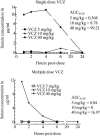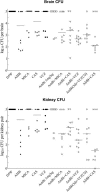Comparative efficacies of conventional amphotericin b, liposomal amphotericin B (AmBisome), caspofungin, micafungin, and voriconazole alone and in combination against experimental murine central nervous system aspergillosis
- PMID: 16304147
- PMCID: PMC1315954
- DOI: 10.1128/AAC.49.12.4867-4875.2005
Comparative efficacies of conventional amphotericin b, liposomal amphotericin B (AmBisome), caspofungin, micafungin, and voriconazole alone and in combination against experimental murine central nervous system aspergillosis
Abstract
Central nervous system (CNS) aspergillosis is a severe disease that responds poorly to current therapies. The current studies examined the efficacies of several antifungal agents alone or in combination with a murine model of CNS aspergillosis. Immunosuppressed mice were infected intracerebrally with Aspergillus fumigatus and treated with an amphotericin B preparation, an echinocandin, or voriconazole (VCZ) given alone or in combination. Monotherapy studies showed that micafungin (MICA), caspofungin (CAS), VCZ, conventional amphotericin B (AMB), Abelcet (ABLC) (a lipid-carried AMB formulation; Enzon Pharmaceuticals, Inc.), and AmBisome (AmBi) (liposomal AMB; Gilead Sciences, Inc.) were efficacious. However, doses of AmBi above 15 mg/kg of body weight showed reduced efficacy. Neither MICA nor CAS showed dose responsiveness at the doses tested (1, 5, or 10 mg/kg). Only the 40-mg/kg dose of VCZ was effective. AmBi and ABLC showed dose responsiveness, with 10-mg/kg doses causing a significant reduction in fungal burden; they had equivalent activities at the 10-mg/kg dose. Suboptimal dosages of AmBi in combination with MICA, CAS, or VCZ were effective in prolonging survival. However, significantly enhanced activity was demonstrated only with AmBi and VCZ in combination. AmBi in combination with MICA or CAS showed a trend toward enhanced activity, but the combination was not significantly superior to monotherapy. The use of AmBi with CAS or VCZ at optimal doses did not improve efficacy. Cure was not attained with any dosage combinations. These results indicate that AmBi in combination with VCZ may be superior for treatment of CNS aspergillosis; combinations of AmBi and MICA or CAS were not antagonistic and may have a slight benefit.
Figures






References
-
- Abruzzo, G. K., C. J. Gill, A. M. Flattery, L. Kong, C. Leighton, J. G. Smith, V. B. Pikounis, K. Bartizal, and H. Rosen. 2000. Efficacy of the echinocandin caspofungin against disseminated aspergillosis and candidiasis in cyclophosphamide-induced immunosuppressed mice. Antimicrob. Agents Chemother. 44:2310-2318. - PMC - PubMed
-
- Adedoyin, A., J. F. Bernardo, C. E. Swenson, L. E. Bolsack, G. Horwith, S. DeWit, E. Kelly, J. Klasterksy, J. P. Sculier, D. DeValeriola, E. Anaissie, G. Lopez-Berestein, A. Llanos-Cuentas, A. Boyle, and R. A. Branch. 1997. Pharmacokinetic profile of ABELCET (amphotericin B lipid complex injection): combined experience from phase I and phase II studies. Antimicrob. Agents Chemother. 41:2201-2208. - PMC - PubMed
-
- Bellmann, R., P. Egger, and C. J. Wiedermann. 2003. Differences in pharmacokinetics of amphotericin B lipid formulations despite clinical equivalence. Clin. Infect. Dis. 36:1500-1501. - PubMed
-
- Bindschadler, D. D., and J. E. Bennett. 1969. A pharmacologic guide to the clinical use of amphotericin B. J. Infect. Dis. 120:427-436. - PubMed
Publication types
MeSH terms
Substances
LinkOut - more resources
Full Text Sources
Medical

